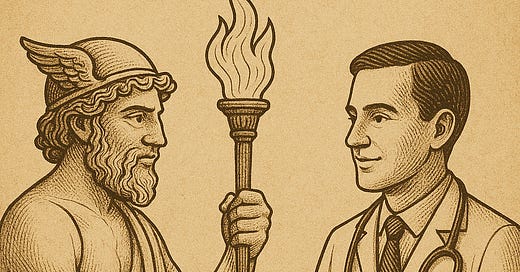Previously, we talked about the crisis of burnout and moral injury that has subsumed healthcare professionals and particularly physicians. I shared how a scientific attitude marries a focus on the evidence and being open-minded about new information that comes our way. We then explored different ways to acquire medical information, including AI (Artificial Intelligence), to enhance our sense of agency and human connection, two major drivers behind burnout.
At this point in the series, I would like to pause and zoom out to the 30,000-foot view to see things at a distance. So, for the next few episodes, I would like to show how ancient and modern myths are an important way to understand how the Health Architect concept can help us face burnout.
I want to start by introducing what myths are. Since ancient times, myths have been sacred stories designed to help us find meaning and purpose in life by guiding our behavior. Whether the Greek legends of Prometheus or Zeus, the Hindu epic tales of Rama and Krishna, the Bible, or the stories of the Buddha, myths helped explain the world and its origins and define human values and behavior. Carried from one generation to the next, myths shape culture by mirroring the struggles and aspirations of a people.
So, what is the relevance to medicine and burnout, you ask? Well, I’ll explain shortly how the practice of medicine is also replete with myths that have guided practitioners for millennia. Some myths in medicine are conceptual – a way to understand disease – while people can also become mythical by embodying powerful ideas. Take Hippocrates, for instance—though a historical figure, he’s often elevated to near-legendary status, with his timeless call to “Do No Harm” that still echoes with reverence in modern medicine. Likewise, the public often views physicians not just as professionals, but as mythic symbols of healing—trusted guides endowed with the power to cure, counsel, and lead.
In this series, I’m explaining the arrival of a new myth in medicine—one that rises to meet the challenges where older myths no longer suffice. Today’s physicians face mounting pressures that demand more than endurance; they call for a renewed sense of meaning and purpose in both life and career. That’s why I’ve introduced the Health Architect: an aspirational archetype for our times, and with it, a new oath—one rooted in agency, human connection, and the courage to reshape the system from within to achieve health and wellness for all – including ourselves.
Ultimately, myths are beliefs shaped by time—they evolve, disappear, reemerge, or endure, mirroring the ever-changing nature of human experience. That fluidity is part of why the word “myth” today often implies something widely believed but fundamentally untrue. We see this in persistent medical misconceptions, like the belief that vaccines overwhelm the immune system or that antibiotics can treat viral infections. In an era where verification and evidence reign, stories often clash with facts. And this tension applies not just to concepts, but to people as well: physicians, for example, are still mythologized as omniscient, God-like figures capable of curing all. These kinds of mythical distortions can misguide public expectations—and they also mislead us when it comes to understanding burnout. That’s the type of erroneous myth I want to examine more closely here.
Myth #1: Myths don’t have any place in medicine.
Fact: False.
This is false because, as mentioned earlier, mythical concepts are pervasive in medicine. Bodily humors, miasma, vitalism, and demonic possession in psychiatric disorders are just some of the mythical concepts that grabbed physicians' attention for centuries. Today, other myths, like naturalism, “alternative” medicine, vitamins, and AI, retain allure.
Myths in medicine also come in the form of individuals who achieved mythical status by embodying their actions and discoveries. These mythical figures in medicine started as purely divine creations, like Asclepius in Greece or Imhotep in Egypt, but over time, they included real people, like Hippocrates, Galen, Florence Nightingale, or Sigmund Freud. Though made of flesh and blood, these individuals gained a divine aura as they morphed into symbols that went way beyond their actual work. For example, Hippocrates came to symbolize non-maleficence (that is, “do not harm”), Galen for physician omniscience, Nightingale for compassionate attention, and Freud for the unconscious.
And let’s add one more big one: Sir William Osler, reputed physician at Johns Hopkins from the late 1800s and early 1900s, is another particularly noteworthy mythical figure who shaped our practice of modern medicine. He standardized the practice of bedside rounds, ultimately embodying a myth of his own making: the “doctor-patient relationship.” Osler still carries a hallowed status among his followers today (as an aside, the almost religious zeal of medical graduates from Johns Hopkins for their local hero is clear when they are seen sporting their “Osler ties” on Fridays beaming with pride). But Osler’s status is somewhat ironic given the fact that many of Osler’s contemporaries actually derided his actions at the time, accusing him of being a “therapeutic nihilist” when he deliberately avoided using elixirs and remedies popular with other practitioners. Rather, his apotheosis, championed first by his students, and then fellow faculty, occurred when he devoted his energy in a different way; not by reaching for useless therapies, but towards conveying empathy and compassion for his patients at the bedside. By doing so, he created the sacrosanct – and now mythical – “doctor-patient relationship” – a professional, intimate bond between two individuals involved in a private medical contract, safely protected at the bedside from the outside world.
The rise of Osler, Freud, Nightingale, and others as mythical figures in medicine and beyond speaks to how the medical community, like all human beings trying to make sense of a chaotic world, needs myths and stories in medicine to guide our morals, ethics, expectations, and behavior. We all need mythical concepts to live by and figures to aspire to.
Today, myths in medicine continue, with many claiming allegiances to them in the form of oaths. Most medical students recite some version of the Hippocratic Oath as part of medical school graduation, though the content has evolved over the years to be more in tune with more current ethical and professional standards of practice. At Mayo Clinic, where I attended medical school, technology itself is incorporated into oath taking, as shown by their Digital Hippocratic Oath.
But myths have their limits, which is why revisiting and, at times, replacing them is essential. Take, for example, the enduring myth of the doctor-patient relationship—often treated as sacred and inviolable. While there’s undeniable value in honoring the trust and intimacy between doctor and patient, we must recognize that this relationship is, at its core, an idealized construct. In our minds, it exists more as an abstract idea that should be shielded from the complex realities of the workplace, whereas in reality, they are influenced by them—whether they are financial constraints, institutional policies, operational demands, technological disruptions, or other pressures. But a more balanced view recognizes that even in Osler’s era, physicians didn’t practice in a vacuum with patients; Osler himself had to navigate pressures related to payment, institutional expectations, and systemic norms. The doctor-patient relationship, therefore, has always been an aspiration—something to strive toward, not a static or absolute truth.
In this context, this is where the mythical concept of the Health Architect comes from. The new oath to be a Health Architect stirs physicians to act and create meaning for us today, just as previous oaths to practice pointed to contemporary myths that shaped the actions of our predecessors. Today’s modern myth of the Health Architect is designed to guide today’s physicians squeezed by informational, financial, interdisciplinary, operational, and technological realities. Being a Health Architect is a model of inspiration and aspiration as we try to evolve ourselves, and our craft, beyond the mundane and unsatisfactory. This myth motivates us to transform our purpose as physicians from a transactional way of being to an experiential one.
Meanwhile, the value of the myth of the Health Architect is amplified because it emerges as a response to another powerful myth: burnout. In today’s medical landscape, burnout takes on the role of a modern demon—an invisible force that drains purpose and erodes connection. Like Odysseus facing the Lotus Eaters or the Sirens in the Odyssey or Arjuna staring across the battlefield at his enemies in the Mahabharata, the Health Architect must confront burnout as a mythical adversary and conquer it, facing the existential challenge not by avoidance or escape, but with a drive to gain inner clarity. As Plato taught us, we all have demons within us – they are part of our nature. Therefore, deliverance doesn't come from external systems, but from self-actualization—reclaiming agency, meaning, and the deeper “why” behind the work. The Health Architect rises not just to endure burnout, but to dismantle it, rebuild medicine, and restore the soul of care.
Take-home point:
To truly confront physician burnout, we must step back and recognize the powerful role of myths in medicine—stories that have long shaped our ideals, values, and professional identities. From legendary figures like Hippocrates and Osler to enduring concepts like the doctor-patient relationship, these myths offer meaning but can also limit us if left unexamined. Today, we need a new myth—the Health Architect—an aspirational figure who reclaims agency, restores human connection, and guides medicine through the complex realities of our time. This modern myth isn’t about escaping burnout, but transforming it into purpose.
In the next episode, we’ll continue our discussion of how the Health Architect myth can help us defeat the demon of burnout, and along the way I’ll debunk a few common incorrect myths about burnout. See you soon.












Share this post